Zhiyin:A Ship of Memories
2017-10-10ByLiuDongli
By Liu Dongli
Zhiyin:A Ship of Memories
By Liu Dongli
1.
“Compared with the powerful and torrential Yangtze River,the Hanjiang River is limpid and joyful. She runs peacefully from the Bozhong Mountains of Shaanxi to Wuhan, singing, moving around the mountains, and bending through the canyons. Hanjiang River would flow to the sea if it weren’t for the Yangtze River lying before her, dictatorially terminating her independent journey.As one who pursues self reliance and freedom, Hanjinag River refuses to lose herself, and strives to find a way out…”
Fang Fang wrote so about the personality of the Hanjinag River in the beginning of The Vicissitudes of Hankou, a book about the past stories of local Wuhan.
Yangtze River and Hangjiang River merge and run together to the sea. So, stories which spread in local Wuhan are closely related to these two great rivers.
Zhiyinhao is one of the ships that sails up and down the rivers,silently experiencing the rising tides and ebbing levels, seeing the birds wandering above the sad and happy faces of Wuhan people. It is a theme ship based on the prototype of Jianghua, a ship forged by Wuhan Minsheng Shipping Company in the early 20th century. Built strictly according to the old fashion, Zhiyin has a rounded bow, two old-type chimneys, and more than 300,000 rivets. She can bring you back for a moment to the 1930s.
According to what Fang Fang narrates, buildings totally different in style from the local warehouses,workshops, and bungalows“appeared along Yangtze River as rapidly as the wind”. After the opening of the port in Hankou (a District of Wuhan), she said, “Locals who lived far from the sea and thus knew little about abroad were greatly stunned by the lifestyle, the material civilization, and the cultural customs of the western world.”
The shock didn’t last for long,though. Wuhan, as a port city,has rooted its open and inclusive culture into its people’s mind. In the process of economic and urban modernization, Wuhan mixed its traditional culture with western culture. Wuhan not only accepted the gardens, the western-style houses, the race course, and the ballrooms from the West, but also became the second biggest city after Shanghai around the Revolution of 1911.
1.
“与气势磅礴、浑厚稳重的长江比,汉水是一条清澈而活泼的河流。它从陕西的嶓冢山一路喧哗奔来,穿山绕峡,蜿蜒跌宕,一直欢乐地跑到武汉。倘若没有长江横亘在前,或许它还想自己奔往大海。可惜浩浩长江切断了它独行的道路。就像一个一心富于个性和自由的人不甘于突然间失去自己一样,汉水也不甘于就这样终结前程。它努力地为自己寻求出路……”
摹写武汉旧事故貌,武汉作家方方的《汉口的沧桑往事》算得上代表作之一。书一开篇,方方就浩浩汤汤地写到汉口的水。
江汉朝宗于海。在武汉,大凡流传的故事,多与长江和汉水有关。
舟行水上,“知音号”是那些往来船只中的一艘,它们在江中颠簸,默默见闻江水涨落、鸥鸟低徊,以及武汉人的愁容和欢颜。
这条以上世纪初武汉民生轮船公司“江华轮”为原型打造的主题轮船,为了再现民国时期老武汉风情,一切都严格按照旧时样式打造:旧式圆润船头,船身30多万颗仿制铆钉,两座老式烟囱……让人仿佛重返上世纪30年代。
方方说,自汉口开埠以来,与本土货栈、作坊、民屋风格完全不同的建筑群“像风一样快速地矗立在长江边上”。“西方人的生活方式、西方人的物质文明、以及西方人的文化习惯,足令居住内陆深处、无缘见识国外的汉口人一时间目瞪口呆。”
但是,惊讶仅仅只是一时间的。
作为码头城市,武汉开放与包容的码头文化已经深深植入武汉人的血液之中。武汉在经济与城市现代化的过程中,将本土的传统文化与欧风美雨的洗礼融汇在一起,不仅接纳了花园、洋房、赛马场、跳舞厅这些西式建筑,还成为辛亥革命前后国内仅次于上海的第二大城市。
民国时期(1911~1949年),是武汉历史上最辉煌的时期之一。这里有战火硝烟,也有歌舞升平,更有商贾往来、精英汇聚。如今,“知音号”就是这段历史最具年代感的“解说员”,向我们诉说着那个年代的老武汉——
2.
“卖报,卖报!”进入知音号码头,刚入检票口,迎面而来的报童就将一份竖版繁体的“号外”塞到每一位游客手中:“快看快看,‘知音号’漂移式多维体验剧,绝对精彩!”
随着人流往前走,连接码头和趸船的栈桥俨然一个热闹的集市,馄饨摊、老石磨、旧报亭、黄包车、老爷车,斑驳的木质地板,吆喝着剪纸、汉绣的货郎……所有的细节都在还原着最原汁原味的老汉口码头风貌,也在暗示着游客,你已经进入了一个不一样的时空。
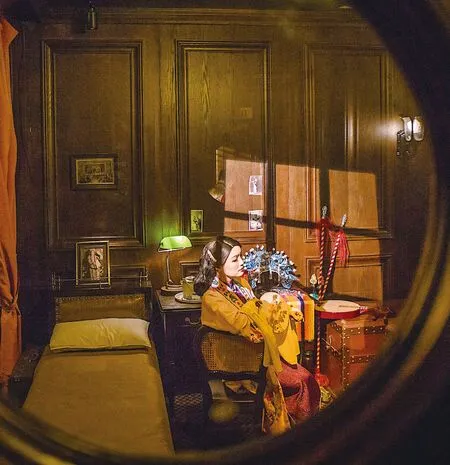
The Republican period (1911-1949)has witnessed the most glorious time in Wuhan’s history. It is a period of war and also a period of peace when merchants from different places bustled about and talents of different nations were jammed.
Now, Zhiyinhao, seemly a living witness from that past period, is here to tell us about the old Wuhan.
2.
“Breaking news! Breaking news!” At the ticket entrance, a newsboy cries,giving an extra of a newspaper printed vertically and written with traditional Chinese characters to each tourist.This is what you are going to see when you arrive at the wharf of Zhiyinhao.
“Look, we have a ‘drifting multidimensional drama’ on Zhiyinhao, it’s de finitely fascinating!”said the boy.
If you walk forward following the crowd, you will see a trestle bridge connecting the wharf and the pontoon. The place looks like a busy market with the old stone mill, an oldstyle newspaper stall, the jinrikisha,vintage cars, the blocky wooden floor,and the street vendors peddling local papercuttings and embroideries. All these together restore a realistic scene of the old Hankou Wharf, reminding tourists that they have stepped into a totally different space.
“Look, isn’t she beautiful in that cheongsam?” My company is talking about a couple who are carrying leather suitcases, walking arm in arm by us. The woman wears a cheongsam and the man wears a long gown.
Looking around, we see on the shipboard all those who live in the Republican period. Some of them are communicating intimately, some saying goodbye to people standing on the wharf, some getting drunk,and some looking for their cabins in a hurry. All of them have their own stories.
Little Yulan is her master’s favourite Dan actress in the Liu Theater Troupe. During the troubled times, the troupe experienced adversity. Little Yulan, who wanted only to marry the “eldest brother” in the troupe, now had no choice but to marry a general in order to save the troupe. In Zhiyinhao’s cabin,she stares at the woman’s headornaments that her master made for her before her first stage show,thinking about the happy days with the “eldest brother”, and bursts into tears.
Next to little Yulan, a dancing girl folds the ship ticket into a paper boat.She is going to leave this city in which she has lived for 20 years, because she has been given away as a gift by her love to his business partner.
“When I was a little girl, my mother told me that if I put a paper boat on the water with my wishes written on it, those wishes would come true. Now I wish to go to a rural primary school,and teach children there to read and dance.”
“你看她穿着旗袍真好看!”我的同伴发现身边有一对身穿旗袍和长衫的夫妻,挽着手,拎着皮箱从身边走过。
再抬头,船舷上都是民国时代的人物,他们有的在亲昵交谈,有的在与船下的人道别,有的喝得酩酊大醉,有的正在匆匆找房间。每个人,都有他们自己的故事——
小玉兰是刘家戏班子最受师傅宠爱的旦角儿。乱世之中,刘家班遭了难,曾经一心想嫁给大师兄的小玉兰不得已决定乘坐“知音号”嫁给将军,以救回戏班。在“知音号”的舱房里,小玉兰看着自己第一次登台时师傅亲手为自己做的头面,想起过去在戏班的种种和大师兄的点滴,不禁潸然泪下。
而在小玉兰的隔壁,一位舞女把手中的船票折成了纸船。她要跟生活了20年的这个城市说再见,因为她的爱人把她当礼物送给了生意伙伴。“小时候母亲告诉我,把心愿写在纸船上放到水里,愿望就会实现。我想要去一所乡村小学,教那里的孩子们识字、唱歌。”
这里的每一位“乘客”,都在动情地讲述着他们的故事,我们需要做的,只是聆听:这里有每天点同一种酒等同一个电话的男人;有总是自己带酒,喝醉就述说情伤的大叔;也有因为家庭阻挠,久别重逢的恋人;还有曾经叱咤汉口的地皮大王,因为洋人入侵土地尽失,他决定发表一份联合声明唤起民意,向洋人抗议。
动荡年代的爱情故事,总会蒙上一层哀伤;战火硝烟中的爱国人士,总会有着一腔悲壮。
我翻阅记录老汉口历史的文献发现,晚清民国时期,武汉至少出现过五大房地产大亨,但能被称为“汉口地皮大王”的,则是一个名叫刘歆生的商人。据说,现在繁华的汉口闹市中心江汉路,起初就是以他的名字命名——歆生路;和歆生路相垂直的三条马路也依次定名为歆生一路、歆生二路、歆生三路(今江汉一路、江汉二路、江汉三路);
1938年,日寇攻进武汉,伪军强占了刘歆生位于汉口循礼门的刘家花园做司令部。日本人想要刘歆生出面当维持会长,为侵略者效力。可是他们始终找不到刘歆生本人。原来早在日军逼近汉口时,刘歆生就警告其家人,不准和日本人做生意。当日军侵入汉口前,他住进了法国租界一直没有露面,直至病重去世。
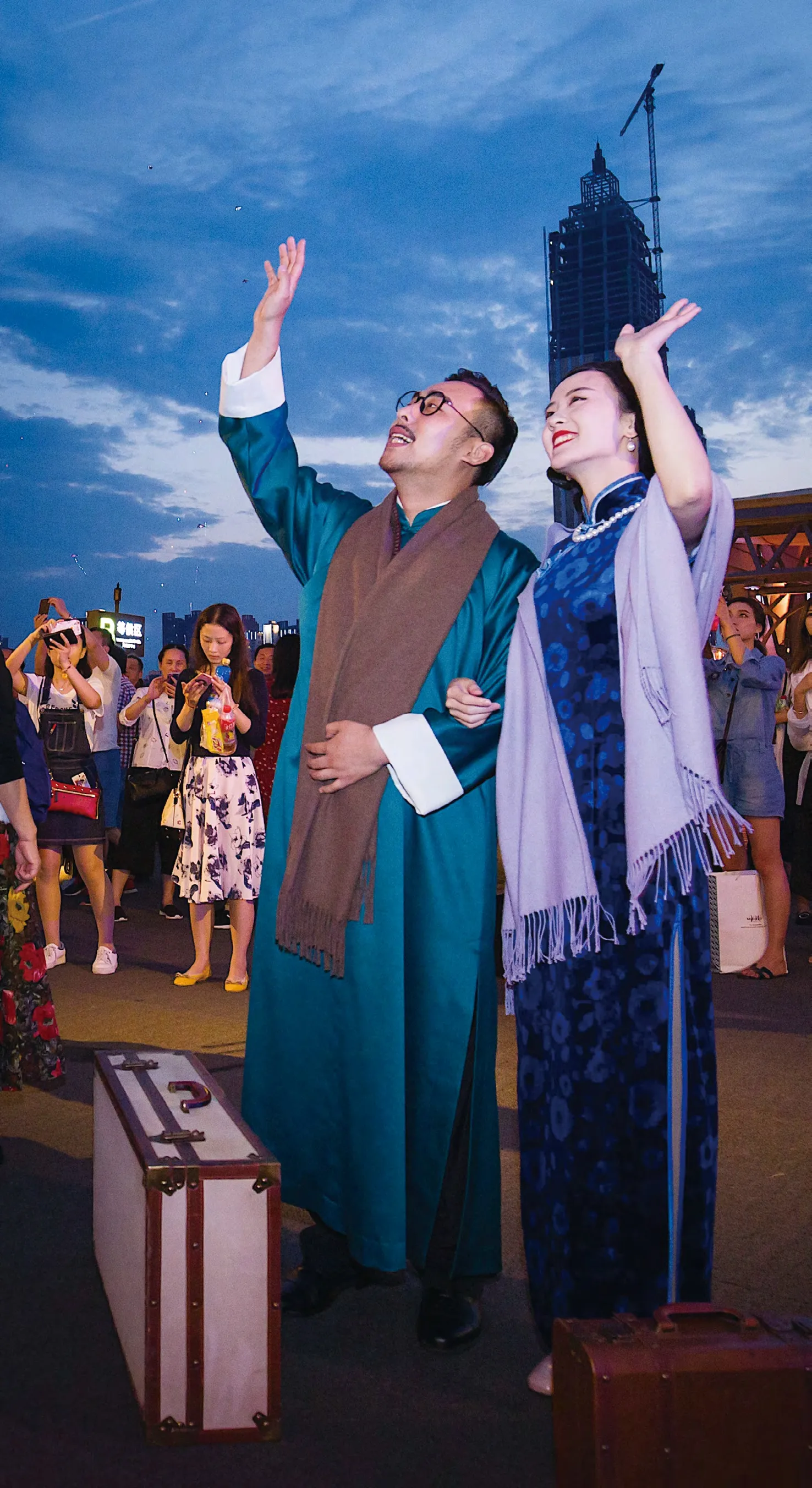
Each “passenger” aboard is telling his/her story emotionally, and all we need to do is to listen. There is a man who orders the same liquor and waits for the same call every day, a drunk middle-aged man who brought his own alcohol aboard and is babbling about his heart break, and a couple who once broke up because of the obstruction of their families and reunites here delightfully. There is also a former “land king” of Hankou.He has lost the ownership of his lands because of the foreign invasion, and now announces a joint statement in order to call up the public to fight against invaders.
Love stories in turbulent times are always eclipsed by sorrow; patriotic personages in war times always become solemn and stirring.
I looked through the historical documents of Hankou and found that during the late Qing dynasty and the Republican period, there had been at least five real estate tycoons, among whom only one businessman named Liu Xinsheng had been called “Land King of Hankou.” It is said that the prosperous Jianghan Road in the center of Hankou downtown was originally named after that “king”as Xinsheng Road; and other three roads were named Xinsheng First Road, Xinsheng Second Road, and Xinsheng Third Road. (Now they are Jianghan First Road, Jianghan Second Road, and Jianghan Third Road.)

In 1938, Wuhan was attacked by the Japanese army and the puppet army; Liu Xinsheng’s garden in Xunlimen, Hankou was occupied for being the headqurters of Japanese Army. The Japanese wanted Liu to serve them and work as a “maintenance mayor,” but they could not find him. It turned out that before the Japanese approached Hankou, Liu had hidden himself in French Concession. The tycoon told his family never to do business with Japanese; he lived in refuge till his death of serious illness.
Fully loaded with stories, Zhiyin is like a microcosm of old Wuhan.Being here to witness the vivid lives in every corner of the ship, you will feel yourself become a part of that history.
3.
The ballroom, the bar, the café,and even the stairs or the corners of corridors… each part of Zhiyin is like a stage where a new episode is being performed. The tourists are so attracted that they can’t look away, almost forgetting that they are traveling on the Yangtze River. When the actors and actresses stop to invite the audiences to the fourth floor, the passengers suddenly find that the ship is already in the middle of the river, and is just passing through under the Second Wuhan Yangtze River Bridge.
The majestic bridge appears quite amazing in the light; and the passengers now have a unique perspective of the bridge. The brightly-lit buildings along the river banks drag people back to the modern reality. Watching from the deck, the lights and the moonlight add radiance and beauty to each other; the river water glitters in both. The buildings existing and those under construction are harmoniously nestling each other.
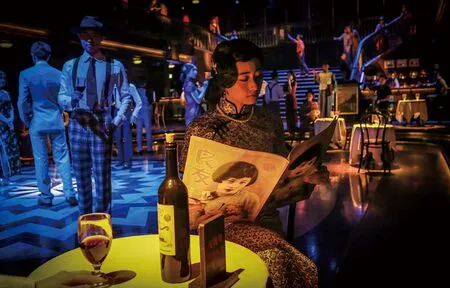
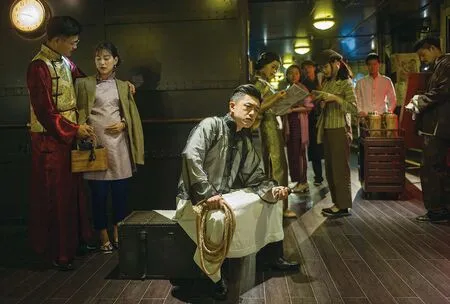
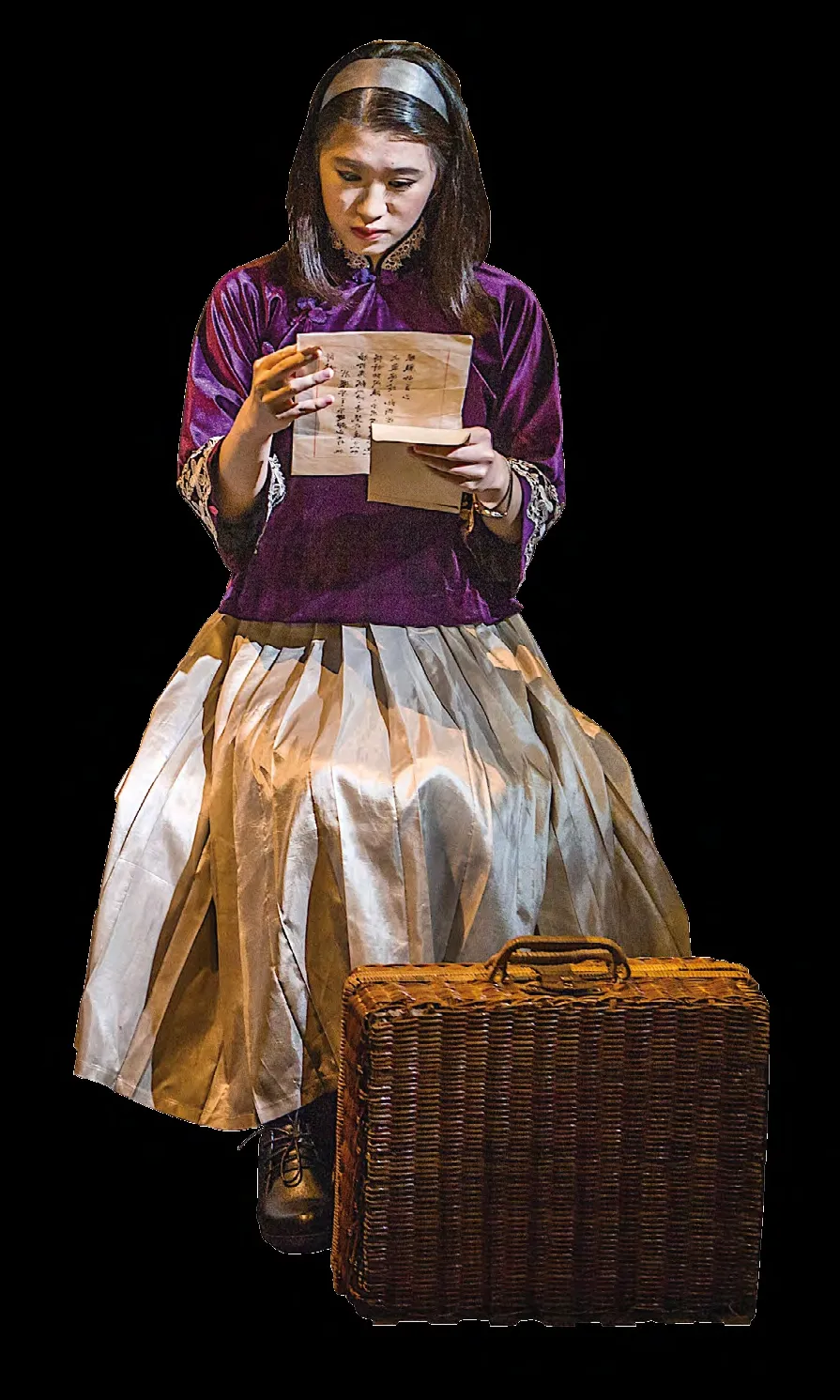
知音号这艘满载故事的船,浓缩了老武汉的过往,就像一个浓缩的小世界,每一个角落都上演着人间百态,而作为观众的你,就是故事的一部分,见证着老武汉的起伏兴衰。
3.
舞厅、酒吧、咖啡厅,甚至是楼梯、走廊拐角,“知音号”的每一个角落都是舞台,每一秒都有新的剧情在上演,吸引着游客几乎没有时间望向窗外,甚至忘了自己身在长江之上漂流。直到演员们邀请大家走上四层甲板,许多人才蓦然发现,此时游轮已行至江水中央,正好从武汉长江二桥下穿过。
这座巍峨壮观的武汉长江二桥在灯光的照射下,十分惊艳。这是长江上独一无二的观桥视角,两岸灯火通明的高楼,一下把人拉回到现实的时空。从甲板上望去,灯月辉映,水色潋滟,已有的和正在兴建的高楼错落有致地相互依傍,使得夜景格外好看,仿佛能看到这座依江而兴的城市的未来模样。
“长江二桥,哎呀,真的是穿越了!”人们纷纷惊叹。
据说,如果在汛期,水位高涨,站在四楼甲板上,个子高的人甚至伸手可以摸到二桥。也正是因为这个原因,为了顺利通过长江大桥和二桥,知音号的烟囱也改为可升降式,避免与桥体发生碰撞。
我们不禁感慨:武汉因水路而发达,因商路而繁盛。经历百年的发展,那艘见证过老武汉变迁的老江华轮,大概怎么也不会想到,在如同天堑的长江上,会飞架起这么多的桥梁。
随着一声汽笛声响,知音号再次靠岸,游客们陆续下船。
在岸上,我将一张写有地址的明信片投入邮箱筒内。地址写的就是我自己的住址,就像是一百年前的我,寄给21世纪的自己。我想,等我收到这张明信片的时候,我也许正在用着智能手机给远在异国的好友发送即时讯息。
正如人们所说,停船下岸,是一个故事的结束,也是另一个故事的开始……
延伸阅读——
“知音号”是由武汉旅游发展投资集团与知名导演樊跃团队联袂打造的文化大剧。该剧以知音文化为灵魂,以大汉口长江文化为背景,重现了上世纪二三十年代大武汉的生活图景,今年4月26日起全球公演。
“知音号”长120米、宽22米、高15米,98个舱室,排水量4015吨。船身由厚重的黑色打底,三层船舱是老照片一样的淡黄色,原木的地板、圆圆的舷窗,近百间客房,走廊、灯光、桌椅、床榻甚至门把手等所有道具,均是精心打造的仿古造型。
有媒体称,“知音号”不仅是一个可以亲身体验百年前武汉风情的大型剧场,更是一座唤醒城市记忆的“漂移的博物馆”。
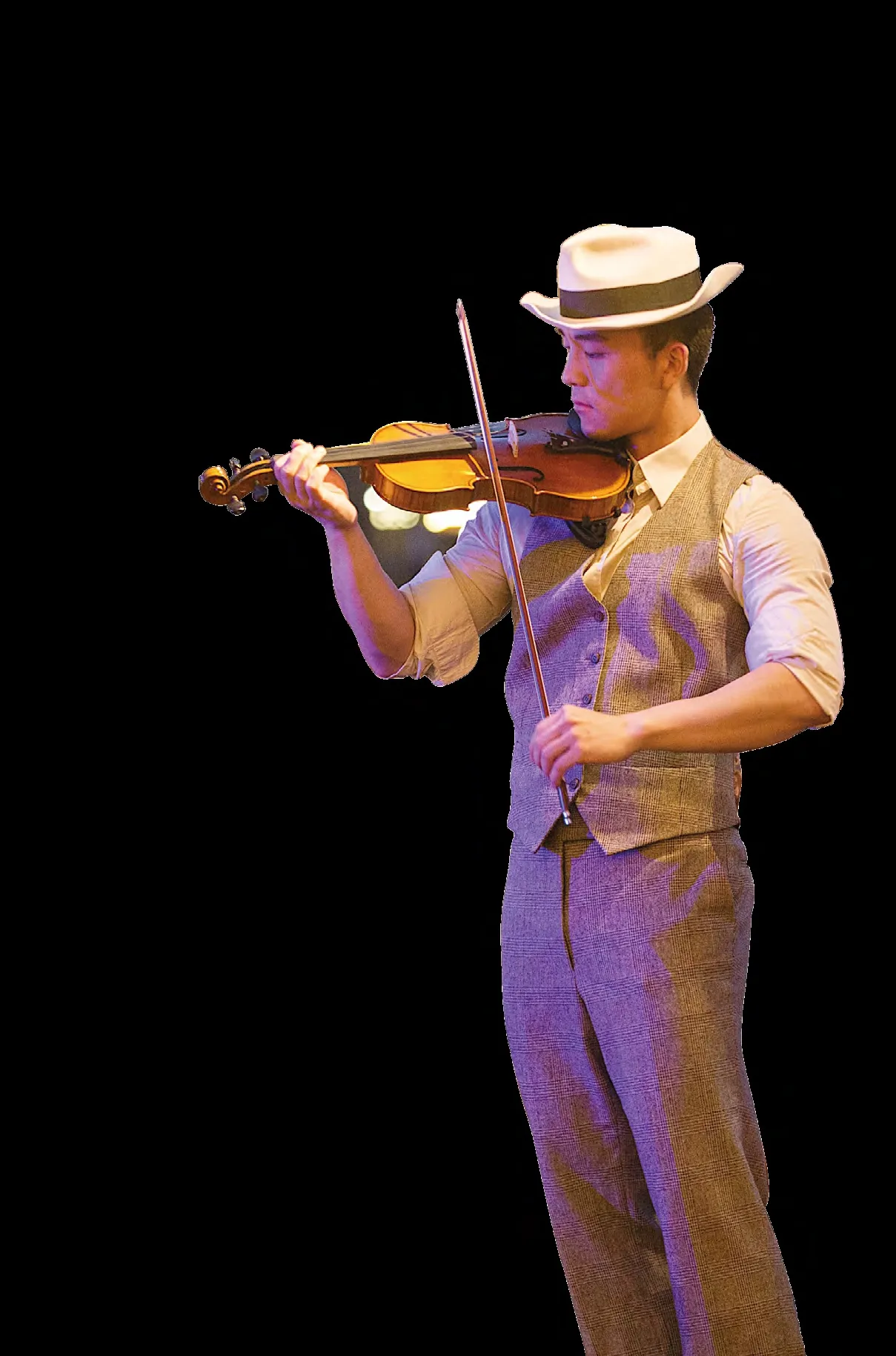
A more prosperous city by the rivers will be there.
“Wow! The Second Yangtze River Bridge! We are really travelling through time”. exclaimed the tourists.
It is said that, in the flood season,the water level will rise up and those tall people who stand on the deck of the fourth floor can even reach out to touch the Second Bridge. For this reason, the chimney of Zhiyinhao is the extendable type in order to avoid crashing on the bridge bottom.
Wuhan flourished on waterways as an important port city. The old ship Jianghua which had witnessed the vicissitudes of old Wuhan would never imagine these many bridges across the mighty Yangtze River built a hundred years later.
With a sound of siren, Zhiyinhao docks again, and tourists disembark in succession. On the shore, I put a postcard with an address into a mailbox. It’s my own address; and it’s like a card sent by a hundredyear-ago person to his 21st-century reincarnation. I might be using my smartphone to send instant messages to my friends in foreign countries when I receive this postcard.
As people say, docking at the shore is the end of a story, as well as the beginning of another…
Background:
The Ship of Zhiyinhao, a form of grand cultural drama, is created by Wuhan Tourism Developing Investment Group and Fan Yue Team, a group of well-known directors.The drama is performed in the style of Zhiyin culture (based on the ancient tale of the friendship between musician Boya and his listener Ziqi) and set in the background of Hankou’s Yangtze River culture; it reproduces life in Wuhan in the 1920s and 1930s. The public premiere performance started on April 26thof this year.
The ship is 120 meters long, 22 meters wide, and 15 meters high. It has 98 cabins,with a displacement of 4,015 tons. The hull is painted a deep black, while the cabins on the three floors are in faint yellow (as appeared in old photos). The timber floor,the round portholes, the one hundred guest rooms, the aisles, the lighting, the tables and chairs, the beds, and even the handles are all of exquisite antique style.
Zhiyinhao, according to some media,is not only a large theater in which tourists can experience the charm of Wuhan 100 years ago, but also a “drifting museum” that awakens the memories of the city.
(Translation: Wang Xiaoke)
知音号一艘关于记忆的轮船
文|刘冬莉
